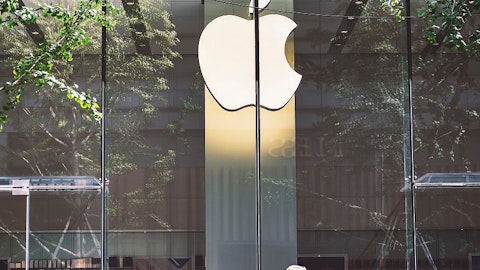Intuit Inc. (NASDAQ:INTU) Q4 2023 Earnings Call Transcript August 24, 2023
Intuit Inc. beats earnings expectations. Reported EPS is $1.65, expectations were $1.38.
Operator: Good afternoon, my name is Raiza, and I’ll be your conference operator. At this time, I would like to welcome everyone to Intuit’s Fourth Quarter Fiscal Year 2023 Conference Call. All lines have been placed on mute to prevent any background noise. After the speakers’ remarks, there will be a question-and-answer period. [Operator Instructions] With that, I’ll now turn the call over to Kim Watkins, Intuit’s Vice President of Investor Relations. Ms. Watkins?
Kim Watkins: Thanks, Raiza. Good afternoon and welcome to Intuit’s fourth-quarter fiscal 2023 conference call. I’m here with Intuit’s CEO, Sasan Goodarzi, and our new CFO, Sandeep Aujla. Welcome, Sandeep, it’s nice to have you on the call. Before we start, I’d like to remind everyone that our remarks will include forward-looking statements. There are a number of factors that could cause Intuit’s results to differ materially from our expectations. You can learn more about these risks in the press release we issued earlier this afternoon, our Form 10-K for fiscal 2022, and our other SEC filings. All of these documents are available on the Investor Relations page of Intuit’s website at intuit.com. We assume no obligation to update any forward-looking statements.

Andrey_Popov/Shutterstock.com
Some of the numbers in these remarks are presented on a non-GAAP basis. We’ve reconciled the comparable GAAP and non-GAAP numbers in today’s press release. Unless otherwise noted, all growth rates refer to the current period versus the comparable prior year period, and the business metrics and associated growth rates refer to worldwide business metrics. A copy of our prepared remarks and supplemental financial information will be available on our website after this call ends. With that, I’ll turn the call over to Sasan.
Sasan Goodarzi: All right. Excellent, Kim, thank you, and thank you, everybody, for joining us today. We had a very strong fourth quarter as we executed on our strategy to be the global AI-driven expert platform, powering prosperity for consumers and small businesses. We grew full year revenue 13%, delivered strong operating margin expansion, and exited the year with momentum. Our overall performance demonstrates the strength of our platform and the diversity of our portfolio, including our ability to maintain earnings power in uncertain times. This past year, we expanded our operating margin again, while investing in the most important areas to drive durable long-term growth. We are guiding to another year of double-digit revenue growth and margin expansion in fiscal year 2024, even with the macroeconomic environment that is uncertain.
We are entering Intuit’s most exciting area. Five years ago, we declared our strategy to be an AI-driven expert platform with data and AI core fueling innovation across our five Big Bets. We’ve made strong progress in transforming from a tax and accounting platform where consumers and small businesses have to do the work to achieve the benefit that they are seeking, to a global financial platform, where we do the hard work for them. Now, we are creating a future of, done for you, a future where the hard work is done automatically on behalf of our customers to fuel their financial success. This future is only possible because of our history of significant investments in our platform, talent, data and AI and now our accelerated investments in generative AI.
At the core of our platform is powerful, relevant data. Intuit has incredibly rich longitudinal, transactional and behavioral data for 100 million customers. For small businesses, we have a 360-degree view of their business and customers. We have 500,000 customers and financial attributes per small business on our platform and this data gives us insights into behaviors, income streams, expenses, profitability, and cash flows, enabling us to provide personalized experiences and recommendations to help them prosper. Additionally, we have 60,000 financial and tax attributes per consumer on our platform, including income, expenses, credit history, spending history, outstanding loans, cash flow, and tax information, which enables us to become a financial assistant in their pocket.
We are using our data to fine-tune our own financial large language models that specialize in solving tax, accounting, cash flow, marketing, and personal finance challenges. The investments that we’ve made in data and AI over the years allow us to introduce innovations at an accelerated rate. Intuit’s rich data platform is a powerful foundation that allows us to create innovative AI-assisted experiences for all of our customers powering their prosperity. In June, we introduced our generative AI operating system called GenOS, to ignite innovation at scale for the benefit of millions of consumers and small businesses. GenOS empowers Intuit technologists to create breakthrough generative AI experiences. We are using a platform approach, giving our teams across Intuit the resources and tools they need to design, build, test and deploy these new experiences with unparalleled speed.
This includes our own powerful financial LLMs, as well as those from other leaders in GenAI, which together unlock new opportunities to serve our customers, in a cost-effective way. We are entering Intuit’s most exciting era yet and believe the next several years will be game changing. On September 6th, we’ll be hosting Intuit Innovation Day, a virtual event where we will unveil exciting GenAI innovation across our platform and how it will drive business growth in the years ahead. We look forward to sharing more with you then. Now, let me turn to our Big Bets which are driving growth and benefits for our customers today. I would like to highlight some examples of recent progress in one of our Big Bets. As a reminder, our five Big Bets are, revolutionize speed to benefit, connect people to experts, unlock smart money decisions, be the center of small business growth, and disrupt the small business mid-market.
Our fourth Big Bet is to become the center of small business growth, by helping our customers get new customers, get paid fast, manage capital and pay employees with confidence in an omnichannel world. In payments, our innovation continues to drive digitization, from creating an estimate, to invoicing a customer, to getting paid. Today, easier discovery, auto-enabled payments, instant deposit, and getting paid upfront, are all helping drive adoption of our payments offering, leading to 22% total online payment volume growth this quarter. We are making significant progress digitizing B2B payments to accelerate and automate transactions between small businesses, and ultimately improve their cash flow. We see a tremendous opportunity as 80% of businesses still pay other firms via paper checks.
We recently expanded the availability of the beta of our native bill pay solution by 10x. Turning to Mailchimp, we are well on our way to becoming the source of truth for our customers to help them grow and run their business. We have three acceleration priorities with Mailchimp. First, delivering on our vision of an end-to-end QuickBooks and Mailchimp customer growth platform. Second, disrupting the mid-market by developing a full marketing automation, CRM and eCommerce suite. And third, accelerating global growth with a holistic go-to-market approach. This last quarter, we implemented our first generative AI capability in Mailchimp, the Email Content Generator, enabling customers to create faster email campaigns based on industry, marketing intent and brand voice.
This quarter, we launched the beta of a new product announcement generator, which uses AI to automatically create an email that a small business can send to its customers. We also announced over 150 new and updated features at our recent Mailchimp conference in London, designed to support the needs of advanced marketers, including a calendar view, custom reporting and analytics, more e-commerce advanced segmentation, more real time behavioral data based on e-commerce automations, and SMS marketing. Lineup changes and free trials are driving positive trends in year-over-year paid customer growth, which accelerated this quarter. We continue to make progress in mid-market, our 90-day retention rate this quarter the highest it’s been in two years.
We have also translated the product into five different languages. We will share more on the outcomes we’re delivering across our five Big Bets at our Investor Day. Wrapping up, with our durable AI-driven expert platform strategy and focus on innovating with GenAI across our products, we are moving at high velocity. This will help us put more money in our customers’ pockets, save them time, and ensure complete confidence in every financial decision they make. As we lead this next technological shift, we are well positioned to power prosperity for our customers and communities that we serve with a leadership team that is built for the era of AI. Now let me hand it over to Sandeep. It’s great to have you on the call, my friend.
Sandeep Aujla: Thank you, Sasan. I’m excited to be here and I look forward to meeting many of you in the future. We delivered strong results in fiscal 2023, including total revenue growth of 13%, strong margin expansion, and GAAP and non-GAAP EPS growth of 15% and 22% respectively. For the fourth quarter of fiscal ’23, we delivered results that exceeded the high-end of our guidance range across all key metrics, including revenue of $2.7 billion, up 12%. GAAP operating income of $17 million versus a loss of $75 million last year. Non-GAAP operating income of $627 million versus $433 million last year up 45%. GAAP-diluted earnings per share of $0.32 versus a loss of $0.20 a year ago and non-GAAP diluted earnings per share of $1.65 versus $1.10 last year, up 50%.
Now turning to the business segments. In the Small Business and Self-Employed Group revenue grew 21% during the quarter and 24% for the full year, which included four points of benefit from a full year of Mailchimp’s revenue this year versus three quarters last year. Online ecosystem revenue grew 21% during the quarter and 30% for the full year. With the goal of being the source of truth for small businesses, our strategic focus within the Small Business and Self-Employed Group is three-fold, grow the core, connect the ecosystem and expand globally. First, we continue to focus on growing the core. QuickBooks Online accounting revenue grew 22% in Q4 and 26% in fiscal ’23. Growth for the quarter and fiscal year were driven mainly by customer growth, higher effective prices and mix shifts.
Second, we continue to focus on connecting the ecosystem. Online services grew 20% in Q4 driven by payroll, Mailchimp, payments, capital and time tracking. For the full fiscal year, ’23 QuickBooks Online Services grew 34% driven by Mailchimp, payroll, payments, capital and time tracking. Within payroll, revenue growth in this quarter reflects an increase in customers’ adopting our payroll solutions and a mix shift towards higher-end offerings. Mailchimp revenue grew mid-teens in Q4. Growth was driven by higher effective prices and paying customer growth. Within payments, revenue growth in the quarter reflects ongoing customer growth as more customers adopt our payments offering to manage their cash flow as well as an increase in total payment volume per customer.
Third, we continue to make progress expanding globally by executing our refreshed international strategy, which includes leading with both QuickBooks Online and Mailchimp in our established markets and leading with Mailchimp in all other markets as we continue to execute on localized product and lineup. On a constant currency basis, total international online ecosystem revenue grew 12% in Q4 and 31% in fiscal ’23. The power of our small business platform continues to resonate with customers as they look to grow their business and improve cash flow across all types of economic environments. Our platform remains critical to our customers’ success and we continue to see them adopt multiple offerings across the platform to manage their business.
Desktop Ecosystem revenue grew 19% in the fourth quarter and QuickBooks Desktop Enterprise revenue grew in the low 20s. We are approximately two-thirds of the way through a three-year transition for customers that remained on license-based desktop offering to a recurring subscription model. We also raised our desktop prices across multiple products last September, consistent with our principle to price for value. Looking ahead, we expect continued strong desktop ecosystem revenue growth next year as we complete the remaining part of the three-year transition. Our focus is to continue building out our online ecosystem and to help our desktop customers migrate seamlessly to our online offerings. We continue to expect the online ecosystem to be our growth catalyst longer-term.
Looking ahead, we continue to anticipate Small Business and Self-Employed revenue growth of 15% to 20% per year in long term. Now shifting to Credit Karma. Credit Karma delivered revenue of $424 million in Q4, down 11%. On a product basis, the decline in Q4 was driven primarily by macroeconomic headwinds in personal loans, auto insurance, home loans and auto loans, partially offset by growth in credit cards and Credit Karma Money. Full year revenue was $1.6 billion down 9%. Credit Karma represented 11% of Intuit’s total revenue in fiscal ’23. We have seen continued stability across our core verticals, which led to the improvement in year-over-year performance during Q4 versus Q3. For context, credit cards and personal loans represented nearly 50% and nearly 30% of Credit Karma’s revenue in fiscal ’23, respectively.
Looking ahead, we continue to anticipate Credit Karma annual revenue growth of 20% to 25% per year long term. Now shifting to Consumer and ProTax groups. Consumer Group revenue was $4.1 billion in fiscal ’23, up 6%. Each tax season has been unique since the pandemic began four years ago, introducing volatility into Consumer Group results. However, average annual trends over this four-year period are more in line with the long-term trends. Over the past four years, Consumer Group revenue increased by an average of 10% annually, which aligns with our long-term growth expectations of 8% to 12%. While this was a unique tax season, I am proud of the progress the team made by transforming the assisted segment with TurboTax Live, which grew revenues 17% this year, while customers grew 12%.
Looking ahead, we are confident in multiple growth drivers. First, we see a large runway ahead of us with TurboTax Live, given our ability to use both GenAI and human experts powered by AI to deliver confidence for our customers. We are investing in scaling our full-service offering, which has a good product market fit based on the highest product recommendation scores of any product at Intuit this year. Second, we are trying to scale our business tax offering, following a successful pilot this year. And third, we see significant opportunities ahead, driving Credit Karma members to TurboTax and giving TurboTax filers faster access to their money with Credit Karma Money. Given the growth opportunities I just shared, we continue to expect annual Consumer Group revenue growth of 8% to 12% per year over the long term.
Turning to the ProTax Group, revenue was $561 million in fiscal ’23, up 3%. Now let me share more on our financial principles and capital allocation. Our financial principles guide our decisions, remain our long-term commitment and are unchanged. We finished the quarter with approximately $3.7 billion in cash and investments and $6.1 billion in debt on our balance sheet. Approximately $4.2 billion of the debt is maturing over the next 15 months and we are evaluating refinancing opportunities subject to market and other conditions. We repurchased $465 million of stock during the fourth quarter and $2 billion during fiscal ’23. Depending on market conditions and other factors, our aim to be — is to be in the market each quarter. The Board approved a quarterly dividend of $0.90 per share payable on October 17, 2023.
This represents a 15% increase versus last year. We recently finalized our three and one year strategic plan. I feel confident in the investments we are making to drive durable growth, including executing across our Big Bet and continuing the accelerated pace of innovation, particularly with GenAI. We have a proven playbook for operating in both good and difficult economic times. We manage for the short and the long-term and control discretionary spend to deliver strong results while investing in what is most important for future growth. Our goal remains for Intuit to emerge from this period of macroeconomic uncertainty in a position of strength. Moving on to guidance. Our fiscal 2024 guidance includes total company revenue of $15.89 billion to $16.105 billion, a growth of 11% to 12%.
Our guidance includes revenue growth of 16% to 17% for the Small Business and Self-Employed Group, 7% to 8% for the Consumer Group, and a decline of 3% to a growth of 3% for Credit Karma. GAAP earnings per share of $9.37 to $9.67, growth of 11% to 15%, and non-GAAP earnings per share of $16.17 to $16.47 growth of 12% to 14%. We expect a GAAP tax rate of approximately 23% in fiscal 2024. Our guidance for the first quarter of fiscal ’24 includes revenue growth of 10% to 11%, GAAP earnings per share of $0.15 to $0.21, and non-GAAP earnings per share of $1.94 to $2. We are taking a prudent approach with guidance given the continued macroeconomic uncertainty. As a reminder, in Q1 of fiscal ’24, we expect to pay approximately $700 million in cash tax payments related to fiscal ’23, which were deferred due to the IRS disaster-area tax relief.
You can find a full fiscal 2024 and Q1 guidance details in our press release as well as on our fact sheet. With that, I’ll turn it back over to you, Sasan.
Sasan Goodarzi: Great. Thank you. And wrapping up, we are confident in our AI-driven expert platform strategy and progress with our five Big Bets, the investments that we are making in GenAI and our leadership team driving our platform innovation. The combination of our assets and our strategy creates a growth flywheel for Intuit to accelerate penetrating our $300 billion in TAM. In today’s uncertain macro-environment, the benefits of our global financial technology platform are more important and mission-critical than ever to our customers. I look forward to your attendance at our Intuit Innovation Day on September 6th, and Investor Day on September 28th. With that, let’s open it up to your questions.
See also 17 Highest Paying Countries for Lawyers and Top 20 Smartest Dog Breeds Ranked.
Q&A Session
Follow Intuit Inc. (NASDAQ:INTU)
Follow Intuit Inc. (NASDAQ:INTU)
Operator: [Operator Instructions] And we’ll take our first question from Keith Weiss with Morgan Stanley. Your line is open.
Keith Weiss: Excellent. Thank you guys for taking the question, and a really nice quarter, and nice to see a forward EPS guide ahead kind of where consensus was to see those numbers start moving up. My inbox getting filled up with questions about the consumer business and the consumer guide. You’ve talked about a longer-term 8% to 12% growth there, the four-year CAGR of 10%, but this year you are looking for 7% to 8%, so below that guidance framework. And I think what people are trying to understand is why that is? Last year was a difficult tax season. Did you pull the levers too hard on pricing? Or what was it, do we need to refill the tank in terms of units like? What is it that’s going to keep this tax season to be underperforming those longer-term targets? Thank you.
Sasan Goodarzi: Hey, Keith, thank you for your question. Let me give you the headline, but allow me to unpack it. I think the headline is we are just simply being prudent. Our focus on future growth and our bullishness does not change at all. Let me unpack that. First and foremost, when you look at the assisted segment, there is a $30 billion TAM, and $20 billion of it is consumer-assisted segment and $10 billion of it is business segment. And the second is the secular shift towards digitization will continue and only accelerate in the years to come. And with that as context, we probably saw some of our biggest green shoots this year, which is why we are probably more bullish about what’s possible in this business than we were even three to four years ago, and I would put it in two buckets, Credit Karma and then the assisted segment.
In Credit Karma, just as a reminder, our vision from the moment that we bought Credit Karma was to create one consumer platform where a consumer can manage their financial lives, manage their money, and get their taxes done in one place. After several years of just rapid experimentation, we had a massive breakthrough this past year where our customer growth within the Credit Karma platform versus a number of Credit Karma members who became TurboTax customers was up 5x and we are scaling that both on the product side and on the business model side as that gives us a lot of confidence going into next year and beyond. The second is going to be assisted segment and that’s in three parts. First and foremost is we actually had product market fit this past year at full service, our biggest focus was how do we scale.
We had some breakthroughs in how to scale. In fact, as you heard from Sandeep, we had our best product recommendations score of any product across the company and we are significantly leaning into that in the coming year. The second is business tax. We launched and learned to get the product market fit in business tax. That is not going to be available, both across our QuickBooks Live platform and directly going to market with TurboTax and we have hundreds of thousands, if not millions of people, will come to TurboTax looking for business tax. We’ve never had an offering. We will next year and we are scaling it. The last thing, I would say in the assisted segment, one of the biggest things that we’ve learned in the last year is local matters.
What that means, people will go on Google, and they will search, if I’m in San Diego is there a pro close to me, while we’ve never been good been found and local and in fact, when you look at the experts that we have, we are 10 miles from every home in household in the United States and so we’re going big on local this year. And so when I look at our green shoots in the assisted segment and in Credit Karma, it gives us a lot of confidence as we look at this coming year and the future and I’ll end with where I started, was the essence of your question about our guidance, we’re simply being prudent given the year that we just had.
Keith Weiss: Excellent. That’s it for me. Thank you.
Sasan Goodarzi: Thank you.
Operator: And we’ll take our next question from Siti Panigrahi with Mizuho. Your line is open.
Siti Panigrahi: Thank you. Great quarter and Sandeep, congratulations on your first earnings call and looking forward to working with you. Sasan, I want to ask about your bill pay, what sort of feedback have you been getting from your beta customer from the QuickBooks native bill pay? And how should we think about the near-term opportunity as you’re switching the legacy powered by payment solution with now your native bill pay? And then on the broader vision side on small business, now that you have full end-to-end cash flow management, now you have AR invoice payment and AP bill pay, then you have money bank accounts. So what is your broader vision in terms of that monetizing the whole ecosystem?
Sasan Goodarzi: Yeah, Siti, thank you for your question. Let me take it in two parts. First and foremost, you’ve heard us in the past year plus talk about digitizing B2B with respect to all of the manual work that gets done today in terms of 80% of the back and forth between small businesses is all sort of paper checks and manual. And our goal has been to digitize all of that. And one last element of what we needed to do was to launch bill pay. I think the headline I would just give is — the feedback we’ve been getting has even gone better than what we thought, and we’re now at a place where we are 10x-ing our beta, and we hope to have it available to all of our customers soon. So we feel very good about what we are seeing in Bill Pay and how fast we’re able to build it based on the platform capabilities that we have and the feedback that we’ve gotten from customers.
I think back to your second question, you’re right. And in fact, the vision I would take you back to is that we have set out to be the source of truth for a business and to truly be the center of small business growth. And in order to do that, we have to have capabilities that not only help a small business grow their customers, retain their customers, market to their customers, but to be able to manage their cash flow and be able to manage their employees. We now have all of those capabilities end-to-end. And I think particularly, what’s important, that advantages us to deliver for our customers is the data and our AI investments that we’ve made in the last five-plus years. And I think I would just encourage you to attend — and if you can attend when it’s on real time, watch the replay of our September 6 Intuit Innovation Day.
And you will see how with our data, AI and GenAI capabilities we help customers manage their cash flow and really digitize all of money movement in a way that’s so intuitive, so easy and delivered at a moment of truth. So we’re quite excited about what’s possible as we look at this coming year, about the years ahead. And let me, by the way, be very explicit that none of our potential innovation that you’re going to experience in September 6 around GenAI is included in our guidance. But we believe it is fundamentally revolutionary as we think about the world we’re going to create in the future.
Siti Panigrahi: Thank you. Thanks, Sasan.
Sasan Goodarzi: You’re very welcome.
Operator: And our next question comes from Brent Thill with Jefferies. Your line is open.
Brent Thill: Sasan, when you mentioned prudent in the tax guide. I’m curious, are you baking in more wiggle room this year than in past years in the guidance or can you just walk through what you mean by prudent?
Sasan Goodarzi: Sure. Great question. Well, first of all, I’ll just take you back to what you already know, but I think it’s important that we start there. This past year, IRS returns, we continue to estimate we’ll be down a couple of points. The do-it-yourself category will be down nearly 1 point. And the driver of that, which we are now certain of, based on all the working analysis that we’ve done, is we had a number of folks that came in to get their stimulus dollars and tax credits, and so it was pandemic driven. And so that created just what you heard from Sandeep, a sort of a very unusual tax season. But then when you step back and look at the last four-year trend, it sort of straightened out. And so what we mean by prudent is really a couple of things.
One, we’re not assuming IRS growth in our numbers this year, and we’re not banking on all of the innovation that I just shared paying off this coming year. And that’s just part of us being prudent because we want to demonstrate to all of you that this is a business that grows 8% to 12%. And by doing so, we must deliver the results. And so it’s just being very intentional and very prudent. As we think about, by the way, our guidance holistically, it’s not just TurboTax, it’s TurboTax, it’s Credit Karma and the way we thought about Small Business. But those are — that’s the sort of the definition of what we mean by prudent.
Brent Thill: Thank you, Sasan.
Sasan Goodarzi: Yeah. You’re very welcome.
Operator: Our next question comes from Michael Turrin with Wells Fargo. Your line is open.
Michael Turrin: Okay. Great. Thanks so much. You delivered outsized margin expansion this past year. You’ve mentioned a focus on cost controls, given the tougher environment throughout the year, realize it’s one of the guiding principles, but maybe, Sandeep, if you can just speak to what’s allowing you to guide for continued margin expansion as a starting point here? And maybe how we should think about what’s allowing for continued margin expansion as you break into the upper 30s there on the operating margin side? Thanks.
Sandeep Aujla: Thanks for the question, Michael. And let me unpack it a little bit. We go through a [indiscernible] planning process, as I shared in the prepared remarks. And due that process, if you look at one of the biggest needle movers to deliver growth both in the near term and the long term, so durable growth levers for the company. And we make sure those are funded for success, inclusive of Big Bets and investments in GenAI. So the 40 to 60 bps of guidance reflects those investments and, quite frankly, reflects the strength and resilience of our platform. As a reminder, this is an expansion we’re delivering on top of the 3.5 points of expansion we delivered over the last three years. As I look ahead, I see plenty of runway for us to continue to operate in accordance with our financial principles to grow expenses slower than revenue, therefore, implying a margin expansion.





